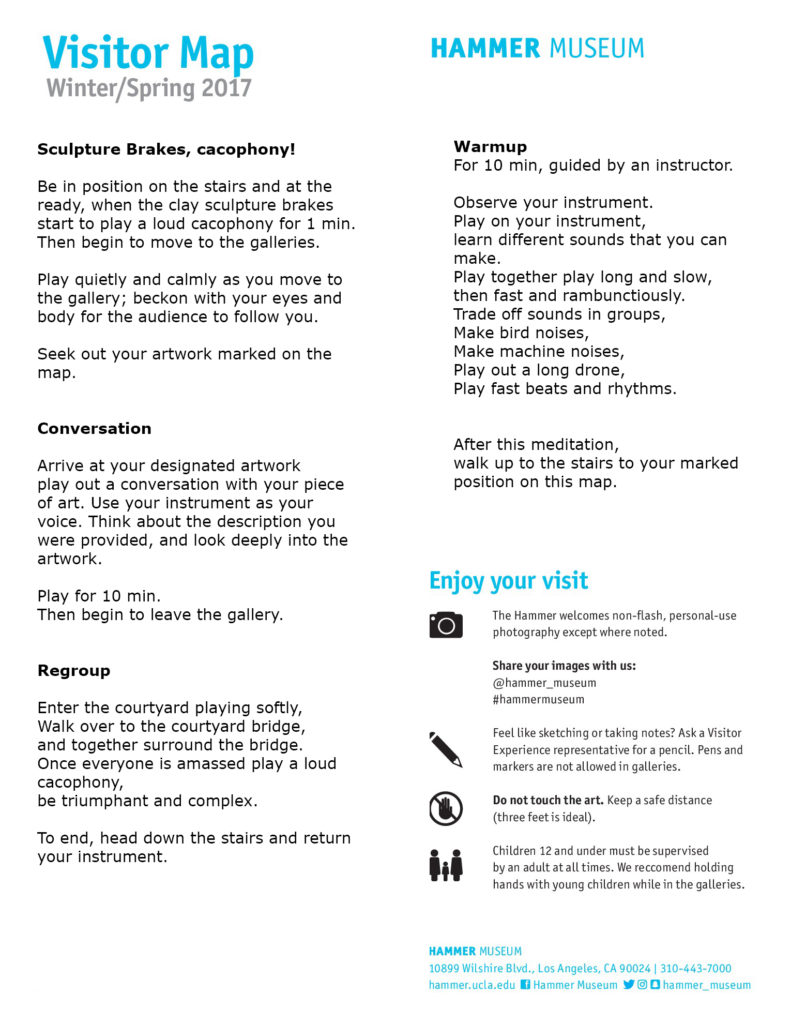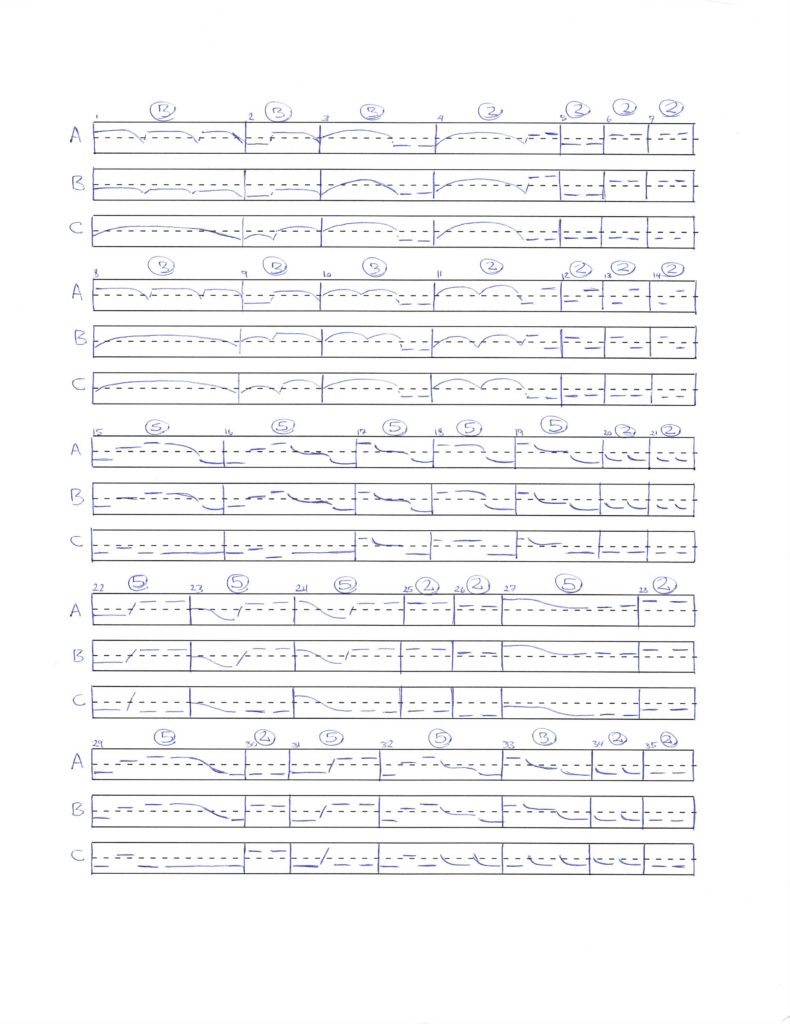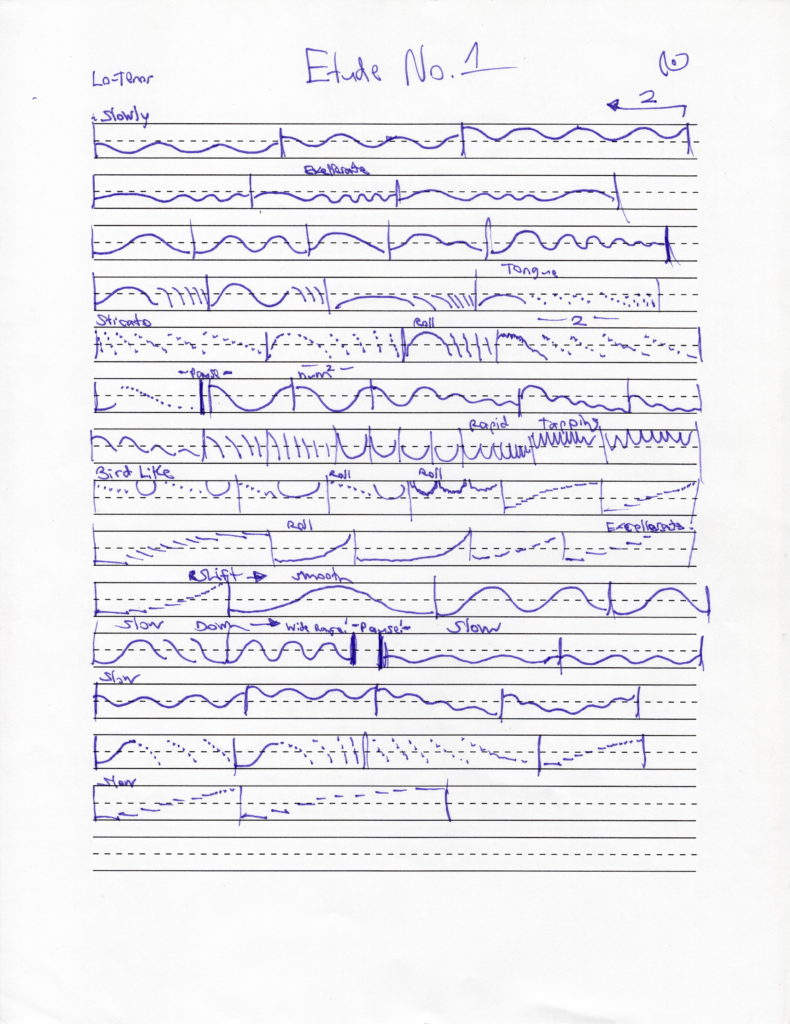TEXT SCORES
Nature Documentary
Score for readers chorus
The score will require two narrators to use a fake British accent and four voices to act as a choir. The choir will make intermittent animal noises after each narration, each choosing randomly from the pronunciations displayed.
Narrator 1- Here are the sounds of songbirds. Listen carefully to the variety, as each songbird has its own distinct call recognizable to others of its species.
Kí-èw kí-èw kí-èw
Fa-‘a-‘a-‘a-ark
Kíkíkíkíkí—āh
Beow beow beow
Narrator 2- Doesn’t that just sound like an afternoon in the garden? Songbirds have been known to chatter senselessly even when no other birds are around; even when no other birds want to hear what they have to say. They just keep chirping away.
Narrator 1- These are the sounds of the beloved housecat. Cats have been domesticated for thousands of years, and because of such their sounds are mostly directed towards human beings.
Rwworwl Rowl
Hsssssssssssss
Prrr pr’ pr’ pr’
Meoow Mrowl
Narrator 2- Cats often make these noises to manipulate their owners. The goal of these manipulations is unknown. Felinologists –people who study cats– speculate that if housecats were larger they would eat the eyes of their owners. So if your living with a cat, your cat likely wants you dead.
Narrator 1- Seals are well known for making noises. These sounds are characteristic of the beach. Seal sounds are known for being incredibly annoying and It can be difficult to hear the soft romance that undercuts the seals calls.
Bah bah bah
Wah wah waaaah
Ih’ ih’ ih’ ih’ ih——-
Guh guh guh
Narrator 2- Seals often produce an intense cacophony of sound to inhibit other animals from enjoying the beach. It is easy to hear the intended rudeness in their calls. Yet some people consider the sound of seals to be beautiful, I’m not sure why. You wouldn’t want to be on the beach, surrounded by seals.
Narrator 1- The mighty horse is known for its noble sounds. Reminiscent of vast open landscapes and untouched nature.
NEIGHHHHHH
Hhhrrrrr Hrrrrrr Hhhrr
Urr Hii Urr Hii Urr Hii
CLOP CLOP CLOP
Narrator 2- Such evocative sounds! Reminiscent of the wild west or a fantasy television drama. Horses are one of the few animals that produces sounds with both their mouths and their feet. It is unknown how they learned to make sounds with their feet to begin with but the sound is amazing none-the-less.
Narrator 1- These are the sounds of the common human. Human vocal chords allow for a wide range of sound production Things such as throat clearing and babbling are common human activities.
Ih uhhhh ah un un
I i i ih me mee
Baba me mey ma mah bibebu
*cough* *cough*
Narrator 2- Note their mumbling nature. Humans are well know for mumbling indistinctly. They frequently think they are communicating clearly, but as a matter of fact you cant understand any of them at all.
Narrator 1- This is the sound of the dog, or so called “mans best friend”. Dogs are well known for co-evolving with humans. It is said that neither would be able to exist today without the other.
Grrrrrrr
Bork Bork Bork
Arf! Arf! Arf! Arf! Arf!
WHOLLF WHOLLF
Narrator 2- Can you hear how the grunting nature of the human pairs perfectly with the dog? Its a very clear indicator of their co-evolution. Even with the aid of one another it is amazing they have managed to last up to today.
Narrator 1- Crows make some of the most well known bird sounds. They are well respected for the elegance of their kawing, its like a symphony.
KAWH! KA’ AWH!
Kak kak kak’kaka kak
K’ k’ k’k’k’ k’
AW AW AW
Narrator 2- The elegance of the crow is unending.
Courtesy Piece 5
Oil the hinges of doors that squeak surrounding a venue.
—–
Oil all of the doors in the school of art at Calarts, preceding the events of ESP night (December 6th 2017).
Place the following description of this action in the concert listing of pieces performed on ESP night.
“The door hinges in the music department and ROD have been oiled prior to this concert.”
Birds
Requirements:
For microtonal ocarina ensemble
For at least 8 performers dispersed throughout a large open space at dusk for at least 10` minutes
Instructions for each performer:
Think of the vocabulary of songbirds.
Think of birdlike chirps and patterns.
Move around the performance space, interacting with others.
You should focus on one-on-one communication.
Play much like you are in conversation.
The sounds you produce should be more melodic then rhythmic.
Think about the sounds and patterns available on your specific instrument.
Think about the way your body interacts with the instrument.
Think about how you interact with others and how your new voice, through the instrument, affects the way you communicate.
Instructions to the group:
Depending on where the performance takes place, planning the progression, the length, and amount of players in the performance may need to happen.
Many spaces such as parks or museums will require the performance to be structured and organized in order to follow their safety regulations.
The group will need to address if the events of the performance develop naturally, with minimal planning, or if the performance will be choreographed.
Meditation 1: Melody
Requirements:
Performed in increments of 15 minutes, for up to 2 hours.
To be performed on any instrument, voice, hum, or whistling.
Instructions:
Sitting in a chair or on the floor, enter a state of meditation.
This is a state of reduced heart rate and calm collected focus.
Focus your vision on nothing specific.
Improvise a melody, producing sound continuously.
Maintain this melody nonstop for the duration chosen.
End producing sound when the duration chosen has been reached.
Variations:
1|2
Perform as a duet between two performers following the above rules, improvising together.
1|3
Perform as a trio between three performers following the above rules, improvising together.
1|4
Perform as a quartet between four performers following the above rules, improvising together.
1|5
Perform as quintet between five performers following the above rules, improvising together.
Limits:
This piece is to be performed by no more then five performers at a time.
VISUAL SCORES


